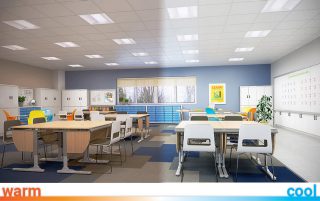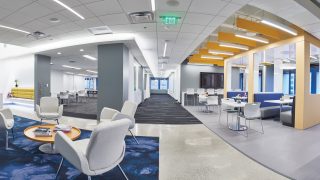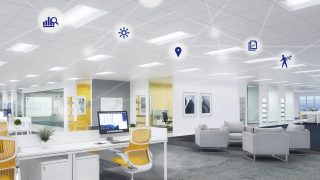Healthcare industry goals have remained fairly constant. Three of the most-often cited goals have included: creating high-quality patient experiences, saving money, and improving care.
However, the solutions that help the healthcare industry achieve these goals are evolving.
Today, most healthcare industry experts have identified these three trends as strategies for helping the industry continue to meet healthcare and operational challenges:
- Being smart and connected to create higher-quality patient experiences.
- More efficiently collecting and using data to save money and improve care.
- Remaining competitive and attracting new healthcare patients or residents.
What do these trends have to do with healthcare lighting? Everything.
Smart and Connected Lighting
If your facility lighting isn’t yet smart and connected, you’re missing out on major benefits.
Energy Efficiency: Smart lighting systems can be programmed to turn lights off in unoccupied areas or adjust the lighting levels based on occupancy and natural light conditions. This helps optimize energy usage and reduce electricity costs.
Patient Well-being: Smart lighting systems can also mimic natural daylight, which has been proven to positively impact mood, sleep patterns, and overall patient experiences. Dynamic lighting can also be used to create calming environments, which is especially important in areas like patient rooms and waiting areas.
Productivity and Staff Satisfaction: Well-lit environments are essential for patient safety, helping reduce the risk of accidents and falls. Smart lighting can be programmed to ensure that areas such as hallways, stairwells, and common spaces are adequately illuminated at all times.
Integrated with Healthcare Systems: Smart lighting systems can work with other technologies, such as patient monitoring and management systems. This integration can enhance the efficiency of healthcare facilities by providing a seamless and connected environment.
Adaptability to Different Activities: Lighting requirements for an examination room are different from those for a corridor. Smart lighting systems can adapt to different activities and requirements, providing appropriate lighting conditions for specific tasks and enhancing the overall functionality of each space.
Remote Monitoring and Control: Facility managers can remotely monitor and control smart lighting systems, allowing for quick response to issues, adjustments, and maintenance – which can lead to faster problem resolution and reduced downtime.
Harnessing Data
Did you know as much as 97% of healthcare data in hospitals goes unused?* Collecting the data is one thing; trying to find the time to analyze it is another. A good lighting system can do both for busy hospital administrators and staff.
Occupancy Monitoring: Lighting systems with built-in sensors can detect occupancy in different areas of the facility. The resulting data can help healthcare facilities optimize space utilization, identify high-traffic zones, and make informed decisions about resource allocation.
Patient Flow Analysis: Lighting data helps analyze the movement of patients and staff throughout the facility. Patient flow patterns and bottlenecks are identified so the layout of spaces can be optimized to improve efficiency.
Energy Consumption Analysis: Collecting data on lighting usage and energy consumption helps healthcare facilities implement energy-saving measures, cost reduction plans, and support sustainability initiatives.
Behavioral Analysis: Lighting data can help healthcare facility managers understand how patients and staff interact with different spaces so they can design more patient-centric and efficient healthcare environments.
Environmental Monitoring: Lighting systems with environmental sensors can monitor temperature, humidity, and air quality. This data can be used to maintain a comfortable and healthy environment for patients and staff. What’s more, it can send alerts when perishables, such as pharmaceuticals, are in danger of spoiling due to temperature or humidity.
Fall Detection and Prevention: Smart lighting systems with advanced sensors can analyze movement patterns and detect anomalies. When an anomaly does occur, the system can trigger alerts or automated responses to mitigate the risk of falls.
Attracting New Customers
Of course, we refer to the people hospitals serve as patients or, in the case of long-term healthcare facilities, residents. But the cold hard fact is that they’re also customers and a healthcare facility must be competitive to attract patients/residents.
Fortunately, lighting can help with that, too.
Integrative (a.k.a. Melanopic or Human-centric) Lighting: Integrative lighting mimics natural daylight, positively influencing circadian rhythms and improving overall well-being. In healthcare settings, integrative lighting can enhance patient experience by promoting better sleep, reducing stress, and supporting the healing process.
Aesthetics and Ambiance: Lighting solutions are available that create a calming and welcoming environment, helping to alleviate anxiety for patients and their families. Attractive lighting design also enhances the overall aesthetic appeal of healthcare facilities.
Color Temperature Control: Today’s lighting solutions often allow for the adjustment of color temperatures throughout the day or night. Warm light creates a more comfortable and relaxing atmosphere that puts patients and visitors at ease, whereas cooler light is often used in areas where alertness and focus are essential – an operating room, for example.
Energy Efficiency: Energy-efficient lighting contributes to a positive image for a healthcare facility and can attract environmentally conscious patients and residents.
Wayfinding and Navigation: The use of strategic lighting can guide patients, residents, visitors, and staff through a facility and vastly improve the overall experience. It makes facilities more user-friendly and reduces the stress associated with navigating a large complex – or even the maze of corridors in smaller facilities.
*weforum.org/agenda/2019/12/four-ways-data-is-improving-healthcare





